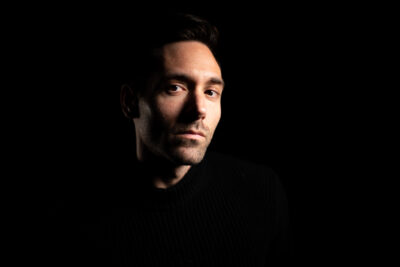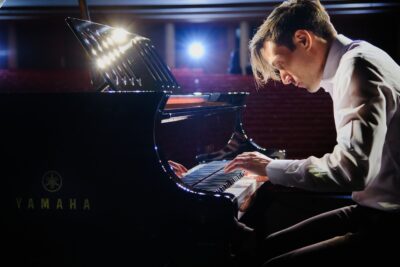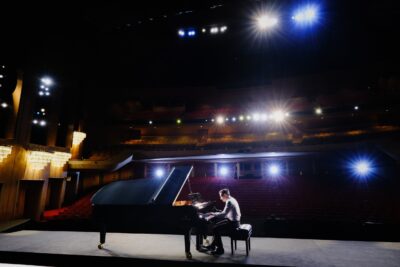“I believe music can be much more than pure intellect. This is why I believe it is important for contemporary works to communicate emotionally because it can lead to a more fulfilling experience.”
Creating something new and different, yet seductive to listeners, has never been easy in classical music, and perhaps least of all in the 21st century. Alfonso Peduto, the Italian composer and pianist, has been very ambitious in this respect for the last ten years and, although young, we could say that he is already fulfilling that task.
He holds a BA in classical composition and music technology from Berklee, an MA in classical composition from the New England Conservatory, and a BA in physics and mathematics from the University of California, Berkeley. This impressive CV wouldn’t matter much if it weren’t the foundation for the music he creates – post-classical, post-minimalist, or post-genre – whatever you want to call it. What makes his compositional process innovative is how numbers flow into complex tonal relationships – thanks to mathematics, Peduto shifted from classical forms to create a musical style rooted in minimalism. In this way, he became the creator of a new musical language. “I have always striven to do things my way, so after a new path was shown to me I took plenty of time to dive deep and find my own answers.”, Alfonso adds.

We may catch glimpses of Chopin, Rachmaninoff, or Scriabin in his music, but Peduto’s authentic expression is what makes the pure piano sound inviting and familiar. He brings the experience of life into his works – contemplative, passionate, complex, indifferent, or completely calm. The listeners recognize this and surrender to that confrontation, finding their own reflection in this mirror. Thus, in Preludes Noirs or some movement of his odes dedicated to Night, Winter, or Silence, Peduto draws us into an exciting black-and-white world, confirming that contemporary music still has the ability to express the dignity of emotions.
The program of the concert scheduled for November 1st at Kolarac concert hall will include a selection of pieces from the last five books he wrote for solo piano: Etudes Noires, Preludes Noirs and the Nacthmusik, Wintermusik and Stillemusik trilogy. As he says, he will perform compositions in inverse chronological order, from the newest to the older ones: “I want to present music for solo piano in a holistic and complementary way. The listener can thus witness some of the evolution of my musical thought from its most current form up to its close origins.” At the end of the concert, he will perform the premiere of his latest work, Devil’s Dance, dedicated to the Dutch minimalist composer Simeon Ten Holt. Ahead of the upcoming performance, Alfonso Peduto talks about his music, a space where art and science merge, in which there is always enough room for personal experiences of the world.
CLASSICALL: Your compositions seem to depict humanity in its various forms. What is the most inspiring thing for you in that joint research of music and your own emotional states and reflections on life?
I am very happy you’ve experienced this reaction to my compositions. Although all of my work is principally guided by formal considerations, such as symmetry, structure, and form, I always try to be in touch with what I feel when I compose. That is for me very important, to make my listener experience what I feel in the moment of creation. I find the practice itself what is exciting. The work itself, the act of sitting down and searching, is what inspires me. Still, emotion stands in my eyes as an exact equal to the formal music-compositional aspects of every piece: that is, I strive to find emotions through the inherent beauty of form.
Why is it important that contemporary classical music communicates emotionally with the listener, and how do you manage to achieve that?

ALFONSO PEDUTO: I am deeply attracted to beautiful ideas, whatever they may be, based on their own merit. I have equally enjoyed, in my formative years, analyzing Beethoven as much as Boulez. Yet I found that, although very interesting and intellectually stimulating, while learning more and more about contemporary works I was losing what had attracted me to music in the first place – that emotional pull that I used to feel when playing, say, a beautiful piece by Chopin, Bach or Rachmaninoff.
Perhaps other people live very fulfilling lives with just a purely intellectual relationship to music. But that is not the case for me, and I believe music can be much more than pure intellect. This is why I believe it is important for contemporary works to communicate emotionally because it can lead to a more fulfilling experience. And at least, that is how I’ve decided to experience the art form, and what I strive to do with my own work.
Which minimalists had the most influence on you and how did the unfairly overlooked composer Simon Ten Holt inspire the work of Devil’s Dance?
The composer who influenced me the most while I was in the process of developing my language is Steve Reich. Reading his paper ‘Music as a Gradual Process’ and listening to his Music for 18 Musicians and Electronic Counterpoint had a profound impact on how I viewed music. I also really enjoyed discovering the works of what I view as the second wave of minimalist authors such as Julia Wolf and David Lang.
I discovered Simeon Ten Holt quite late in this process. I had already developed an extensive catalogue of music for solo and multiple pianos and I was shocked to find an author whose artistic merit stood way above his notoriety and whose language I found so close to mine. I believe he is an under-appreciated modern giant who should be played and listened to more. After listening to much of his music I discovered he wrote a series of pieces, each named Soloduiveldans, Solo Devil’s Dance. I loved the concept, the name, and the scope, so I was compelled to write something in the same spirit that would be dedicated to him. In the spirit of his series, my Devil’s Dance is a single-movement 28-minute work for solo piano where one single ostinato takes the lead as the protagonist of the whole work.
Your knowledge of mathematics steered you towards minimalist music. How would you explain the connection between numbers and music?

Mathematics is related to music’s genetic code. I view music as much as a science as it is an art, from the fact that it is very exact and logical, and its beauty can be uncovered in precise processes, in symmetries, in elegant note-to-note relationships. I believe that is the case for many of repertoire’s masterpieces, even when, at first glance, that may not be the first thing that comes to one’s mind.
In my 2016 collection Sequences, a book for multiple pianos, I have actually purposefully employed mathematics formally in the compositional stage, in order to determine notes and rhythmic decisions. In that collection, I have employed mathematical sequences, borrowed from analysis, which gives the name to the collection, and permutation groups, borrowed from abstract algebra. Since then, the relationship between my mathematics and my music has been more free, and less formal, but I always strive to find beauty in the exactitude of forms and elegant structures. Independent of it, I also find that having studied mathematics has made me a better composer, purely musically speaking, of the way that it molds and trains the brain. I truly believe it can be a fruitful activity for any musician.
And when we add the influence of new technologies to such a compositional process? With the Yamaha Disklavier you often play on, are there limits to piano expressive possibilities?
The relationship between music and technology is also one that is very close to my heart. Musical instruments themselves are first and foremost a piece of technology, they’re human-made and designed, which have allowed us to express ourselves in new ways. We should thus not be afraid to think about how else we can push our art with what we currently have in this day and age, where so much technological advancement has taken place. That is why I am a big fan of Yamaha’s Disklavier technology, as it allows me to create things that I simply cannot create with a traditional piano. First and foremost, the Diskalvier allows me to realize music for multiple hands without the need for other performers. Also, its input-output capabilities allow me to program the instrument in ways to make it react immediately to what I play so that I can have a true real-time conversation with the instrument. I am inspired by this piece of technology, and I am always looking for new ways to explore the piano’s expressive possibilities in new directions. And thus far I feel I am only just scratching the surface.
Finally, what would you say – will the two hands and a regular piano continue to inspire in the future? Will it be enough?
Although I have built an extensive catalog of solo piano, for multiple pianos and music specifically designed for the Disklavier, I’ve always been interested in a variety of different ensembles and mediums to express my musical ideas. I have written a bit in the past for choir, chamber, and orchestra, with the multi-layered musical language that I have developed for piano, and I have some projects for the near future that will allow me to expand in those directions. I am also always on the lookout for more ways to do so. Regardless, my unconditional love for piano and technology will always keep me busy in my attempt to push boundaries and uncover new territories of musical expression.
Ivana Ljubinković
Follow us on Facebook ClassicAll – all the classics you can handle
and on YouTube ClassicAll Radio
